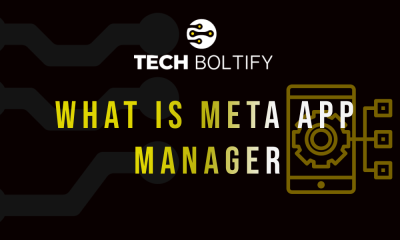Tech
ERP — A New Era – Beyond Dynamics NAV’s Support
Need to stay up to date with major ERP system updates?
After Microsoft Dynamics NAV comes to an end, companies need to think hard about their ERP future.
And here’s the thing…
This ERP landscape is changing rapidly. Projections show the world ERP market is estimated to be 8% increasing from 2022 to reach $147.7 billion by 2025.
What you’ll discover:
- Understanding the ERP Evolution
- Critical Timeline Updates
- Migration Options Explored
- Future-Proofing Your Business
The ERP Landscape is Evolving
Extending Dynamics NAV support doesn’t mean you’ll just miss updates — it’s the turning point of business technology.
Here’s why this matters…
Industry report says by 2025 more than 85% of businesses will adopt a cloud-first mindset. This massive shift means:
- Existing on-premise solutions are becoming redundant.
- Cloud ERP has become the norm.
- Integration capabilities are more important than ever.
Businesses that use a Navision system should start thinking about their migration now.
The Effect on Your Business
This migration away from Dynamics NAV is affecting every facet of the company’s operation. The ERP market share of large businesses stands at 39% and that of small and midsized companies rises at 7% yearly through 2025.
Here’s what this means for you:
The finance sector now represents 26 percent of the ERP revenue. This isn’t surprising because:
- Financial operations need strong, secure processes.
- Standards are increasingly becoming tougher to comply with.
- Live reporting is mandatory.
- Integration with other systems is vital.
Wanna know the best part?
ERP solutions are getting more powerful and easily accessible. Analytics forecast AI integration into ERP systems is expected to increase at a very high rate of 36.6% per year between 2023 and 2030.
The Ultimate Timeline You Must Know
For Dynamics NAV users, the time is evaporating. With support shutting down, companies are exposed to rising risks such as:
- Security vulnerabilities
- Compliance issues
- Limited functionality
- Integration challenges
- Performance bottlenecks
Working without support is like driving without insurance. It may run just fine now, but when it crashes, you’re left with nothing.
The North American ERP market alone, at more than $20 billion in 2024, is estimated to surpass $50 billion by 2025. That exploding scale is fuelling exponential innovation in:
- Cloud infrastructure
- Mobile accessibility
- AI-powered analytics
- Integration capabilities
- Automated workflows
Going Where You Need To Go: Your Migration Options
What the average company doesn’t know…
Not only does the end of NAV support present a challenge – it offers a chance to modernize your entire business. – Industry-specific ERP solutions are needed more than ever in areas such as:
- Healthcare
- Food production
- Manufacturing
- Distribution
- Professional services
Why is this important?
Each industry has different issues and requirements. All modern ERPs have this capability in their very core.
But here’s the kicker…
This ERP system is not something you will select on a whim. Choose based on what is right for you and where you are going. Organisations that select industry-specific offerings report:
- Faster implementation times
- Higher user adoption rates
- Better compliance management
- Improved process efficiency
- Stronger ROI
The Advantages of AWS-Based Solutions
Wondering how modern ERP differs from Dynamics NAV?
It’s all about the cloud.
The advantages of a cloud ERP platform over traditional on-premise ERP solutions such as NAV:
Accessibility:
- Work from anywhere with an internet connection.
- Receive real-time data on any mobile platform.
- Communicate information easily across teams.
- Connect remote workers instantly
Security:
- Automatic security updates
- Enterprise-grade data protection
- Regular backup systems
- Disaster recovery built-in
Scalability:
- Add users as needed
- Expand functionality easily
- Charged for use!
- Growth without hardware limits
And what few people realize…
The savings can be substantial. With cloud-based ERP, you eliminate:
- Hardware maintenance costs
- Server room expenses
- IT infrastructure overhead
- Regular upgrade fees
- Backup system costs
AI Incorporation: The Revolution?
Don’t you remember those AI growth numbers we talked about earlier?
AI integration is on the rise, at 36.6% per year for a reason. Modern ERPs use artificial intelligence to:
- Automate routine tasks
- Predict maintenance needs
- Detect fraudulent activities
- Optimize inventory levels
- Forecast sales trends
But here’s something interesting…
AI’s real ERP-systems virility lies in its flexibility. Even old-school systems, such as NAV, could only do what they were told to do.
Introducing AI-driven ERP systems of the present day is another story. They:
- Take lessons from your business habits.
- Adapt to changing conditions
- Identify improvement opportunities
- Suggest process optimizations
- Prevent potential problems
Consider the implications for your business…
Your ERP system is a strategic decision partner as opposed to simply keeping track of data. Industry analysts expect it to change the way businesses work in the future.
Guaranteed Success With Your Migration Service
And that’s the thing about ERP migrations…
They can be complicated but not painful. The secret is that you need a plan in advance. Consider these critical success factors:
Data Migration:
- Identify essential data
- Clean existing records
- Map data structures
- Validate transferred information
- Archive unnecessary data
User Training:
- Create training materials
- Schedule hands-on sessions
- Identify power users
- Document new processes
- Provide ongoing support
But that’s not all…
You also need to consider:
- System integration requirements
- Custom functionality needs
- Reporting requirements
- Security protocols
- Compliance standards
The Cost of Waiting
Wanna know what’s the biggest mistake a company makes?
Too long in getting started on their migration plan.
Here’s why that’s dangerous:
- Reduced efficiency
- Integration difficulties
- Innovation barriers
Planning Your Path Forward
The good news?
You still have time to execute a tactical switch. But you’ve got to plan ahead. So here’s a tested formula:
- Assessment Phase
- Document current processes
- Identify pain points
- List must-have features
- Calculate ROI potential
- Set clear objectives
- Selection Process
- Research available solutions
- Compare vendor offerings
- Check integration capabilities
- Evaluate implementation support
- Review pricing models
- Implementation Strategy
- Create detailed timeline
- Assign team responsibilities
- Plan data migration
- Schedule training sessions
- Set up testing procedures
The Conclusion: What Now?
Disappointment from Dynamics NAV support is more than just a challenge — it’s an opportunity to transform your business. By transitioning to an ERP platform of the modern era, you can:
- Leverage powerful AI capabilities
- Embrace cloud flexibility
- Enhance security measures
- Improve user experience
- Drive business growth
Here’s something to think about…
The more time you leave it, the faster your rivals could be out-maneuvering you with ERP technology. The ERP market in North America is forecasted to grow to $50 billion by 2025 for a good reason – companies realize the importance of the current technology.
Don’t get caught by surprise when the NAV support ends. Get started on your migration today:
- Assessing your current system
- Documenting your requirements
- Researching modern solutions
- Planning your timeline
- Building your team
Keep this in mind: Transitions start with a plan. Do it now and keep your business afloat in the ever-changing online environment.
Frequently Asked Questions
When is the last date for NAV support?
Microsoft discontinued mass-market support for Dynamics NAV. No more security updates, bug fixes, or support.
What are the risks of trading on NAV?
The primary threats are security risks, compliance, lack of features and rising maintenance expenses.
How long is migration on average?
Migration times are dependant on the complexity, and typically take between 3 – 6 months for small businesses and 6-12 months for larger businesses.
Tech
The Complete Guide to AI Comment Classification: Spam, Slander, Objections & Buyers
Meta ad comment sections are unpredictable environments. They attract a mix of users—some legitimate, some harmful, some automated, and some simply confused. For years, brands relied on manual review or simple keyword filters, but modern comment ecosystems require more advanced systems.
Enter AI comment classification.
AI classification engines evaluate language patterns, sentiment, intention, and user context. They categorize comments instantly so brands can prioritize what matters and protect what’s most important: trust, clarity, and conversion.
The Four Major Comment Types
1. Spam & Bots
These include cryptocurrency scams, fake giveaways, bot‑generated comments, and low‑value promotional content. Spam misleads users and diminishes ad quality. AI detects suspicious phrasing, repetitive patterns, and known spam signatures.
2. Toxicity & Slander
These comments contain profanity, hostility, misinformation, or attempts to damage your brand. Left unmoderated, they erode trust and push warm buyers away. AI identifies sentiment, aggression, and unsafe topics with high accuracy.
3. Buyer Questions & Objections
These represent your highest-value engagement. Users ask about pricing, delivery, sizing, guarantees, features, or compatibility. Fast response times dramatically increase conversion likelihood. AI ensures instant clarification.
4. Warm Leads Ready to Convert
Some comments come from buyers expressing clear intent—“I want this,” “How do I order?”, or “Where do I sign up?” AI recognizes purchase language and moves these users to the top of the priority stack.
Why AI Is Necessary Today
Keyword lists fail because modern users express intent in creative, informal, or misspelled ways. AI models understand context and adapt to evolving language trends. They learn patterns of deception, sentiment clues, emotional cues, and buyer intent signals.
AI classification reduces the burden on marketing teams and ensures consistent and scalable comment management.
How Classification Improves Paid Media Performance
• Clean threads improve brand perception
• Toxicity removal increases user trust
• Fast responses increase activation rate
• Meta rewards high-quality engagement
• Sales teams receive properly filtered leads
For brands spending heavily on paid social, classification isn’t optional—it’s foundational.
Tech
How To Bridge Front-End Design And Backend Functionality With Smarter API Strategy
Introduction: Building More Than Just Screens
We’ve all seen apps that look sharp but crumble the moment users push beyond the basics. A flawless interface without strong connections underneath is like a bridge built for looks but not for weight. That’s why APIs sit at the heart of modern software. They don’t just move data; they set the rules for how design and logic cooperate. When APIs are clear, tested, and secure, the front-end feels smooth, and the backend stays reliable.
The reality is that designing those connections isn’t just “coding.” It’s product thinking. Developers have to consider user flows, performance, and future scale. It’s about more than endpoints; it’s about creating a system that’s flexible yet stable. That mindset also means knowing when to bring in a full-stack team that already has the tools, patterns, and experience to move fast without cutting corners.
Here’s where you should check Uruit’s website. By focusing on robust API strategy and integration, teams gain the edge to deliver features user’s trust. In this article, we’ll unpack how to think like a product engineer, why APIs are the real bridge between design and functionality, and when it makes sense to call in expert support for secure, scalable development.
How To Define An API Strategy That Supports Product Goals
You need an API plan tied to what the product must do. Start with user journeys and map data needs. Keep endpoints small and predictable. Use versioning from day one so changes don’t break clients. Document behavior clearly and keep examples short. Design for errors — clients will expect consistent messages and codes. Build simple contracts that both front-end and backend teams agree on. Run small integration tests that mimic real flows, not just happy paths. Automate tests and include them in CI. Keep latency in mind; slow APIs kill UX. Think about security early: auth, rate limits, and input checks. Monitor the API in production and set alerts for key failures. Iterate the API based on real use, not guesses. Keep backward compatibility where possible. Make the API easy to mock for front-end developers. Celebrate small wins when a new endpoint behaves as promised.
- Map user journeys to API endpoints.
- Use semantic versioning for breaking changes.
- Provide simple, copy-paste examples for developers.
- Automate integration tests in CI.
- Monitor response times and error rates.
What To Do When Front-End and Backend Teams Don’t Speak the Same Language
It happens. Designers think in pixels, engineers think in data. Your job is to make a shared language. Start by writing small API contracts in plain text. Run a short workshop to align on fields, types, and error handling. Give front-end teams mocked endpoints to work against while the backend is built. Use contract tests to ensure the real API matches the mock. Keep communication frequent and focused — short syncs beat long meetings. Share acceptance criteria for features in user-story form. Track integration issues in a single list so nothing gets lost. If you find repeated mismatches, freeze the contract and iterate carefully. Teach both teams basic testing so they can verify work quickly. Keep the feedback loop tight and friendly; blame only the problem, not people.
- Create plain-language API contracts.
- Provide mocked endpoints for front-end use.
- Contract tests between teams.
- Hold short, recurring integration syncs.
- Keep a single backlog for integration bugs.
Why You Should Think Like a Product Engineer, Not Just A Coder
Thinking like a product engineer changes priorities. You care about outcomes: conversion, help clicks, retention. That shifts API choices — you favor reliability and clear errors over fancy features. You design endpoints for real flows, not theoretical ones. You measure impact: did a change reduce load time or drop errors? You plan rollouts that let you test with a small cohort first. You treat security, observability, and recoverability as product features. You ask hard questions: what happens if this service fails? How will the UI show partial data? You choose trade-offs that help users, not just satisfy a design spec. That mindset also tells you when to hire outside help: when speed, scale, or compliance exceeds your team’s current reach. A partner can bring patterns, reusable components, and a proven process to get you shipping faster with less risk.
- Prioritize outcomes over features.
- Measure the user impact of API changes.
- Treat observability and recovery as product features.
- Plan gradual rollouts and feature flags.
- Know when to add external expertise.
How We Help and What to Do Next
We stand with teams that want fewer surprises and faster launches. We help define API strategy, write clear contracts, and build secure, testable endpoints that front-end teams can rely on. We also mentor teams to run their own contract tests and monitoring. If you want a quick start, map one critical user flow, and we’ll help you design the API contract for it. If you prefer to scale, we can join as an extended team and help ship several flows in parallel. We stick to plain language, measurable goals, and steady progress.
- Pick one key user flow to stabilize first.
- Create a minimal API contract and mock it.
- Add contract tests and CI guards.
- Monitor once live and iterate weekly.
- Consider partnering for larger-scale or compliance needs.
Ready To Move Forward?
We’re ready to work with you to make design and engineering speak the same language. Let’s focus on one flow, make it reliable, and then expand. You’ll get fewer regressions, faster sprints, and happier users. If you want to reduce risk and ship with confidence, reach out, and we’ll map the first steps together.
Tech
Which SEO Services Are Actually Worth Outsourcing? Let’s Talk Real-World Wins
Okay, raise your hand if you thought SEO just meant stuffing keywords into blog posts and calling it a day. (Don’t worry, we’ve all been there.) Running a business comes with enough hats already, and when it comes to digital stuff, there’s only so much you can do on your own before your brain starts melting. The world of SEO moves quick, gets technical fast, and—honestly—a lot of it’s best left to the pros. Not everything, but definitely more than people expect. So, let’s go through a few of those SEO services you might want to hand off if you’re looking to get found by the right folks, minus the headaches.
Technical SEO—More Than Just Fancy Talk
If you’ve ever seen a message saying your website’s “not secure” or it takes ages to load, yeah, that’s technical SEO waving a big red flag. This stuff lives under the hood: page speed, mobile-friendliness, fixing broken links, and getting those little schema markup things in place so search engines understand what the heck your pages are about.
You could spend hours (days) learning this on YouTube or DIY blogs, but hiring a specialist—someone who does this all day—saves you a load of stress and guesswork. Sites like Search Engine Journal dig into why outsourcing makes sense, and honestly, after one too many late-night plugin disasters, I’m convinced.
Content Writing and On-Page Optimization (Because Words Matter)
Let’s not dance around it: great content still rules. But search-friendly content is a different beast. It needs to hit the right length, work in keywords naturally, answer genuine questions, and actually keep visitors hooked. Outsourcing writing, especially to someone who actually cares about your brand’s tone, is worth it for most of us.
On-page SEO, which is tweaking all those little details like titles, descriptions, internal links, and image alt text, is a time-eater. It’s simple once you get the hang of it, but when you’re trying to grow, outsourcing makes the most sense.
Link Building—Trickier Than It Looks
Here’s where things get a bit spicy. Backlinks are essential, but earning good ones (not spammy or shady stuff) takes relationship-building, tons of outreach, and real patience. You can spend all month sending emails hoping someone will give your guide a shout-out, or you can just hire folks with connections and a process. Just watch out for anyone promising “hundreds of links for dirt cheap”—that’s usually a shortcut to trouble.
Local SEO—Getting Seen in Your Own Backyard
Ever tried showing up for “pizza near me” only to find yourself on page 7? Local SEO isn’t magic, but it takes a special touch: optimizing your Google Business Profile, gathering reviews, and making sure your info matches everywhere. It’s honestly a job in itself, and most small teams find it way easier to have a local SEO pro jump in a few hours a month.
Reporting and Analytics—Don’t Go Blind
Last, don’t skip out on real reporting. If nobody’s tracking what’s working—and what’s not—you’re just flying blind. Outsourced SEO pros come armed with tools and real insights, so you can see if your money’s going somewhere or just swirling down the drain.
Wrapping Up—Be Realistic, Outsource Smarter
You’re good at what you do, but SEO is more like ten jobs rolled into one. Outsource the parts that zap your time or make your brain itch, and keep what you enjoy. Focus on the wins (more leads, higher rankings, fewer headaches), and watch your business get the attention it deserves.
-
Tech1 year ago
AI and Freight Management
-

 Tech2 years ago
Tech2 years agoLPPe Service Android App and its Functions – How to Remove it
-

 Tech1 year ago
Tech1 year agoWhat is a Permission Controller – Control Manager Notifications
-

 Tech2 years ago
Tech2 years agoWhat is Device Keystring App On Android
-

 Tech2 years ago
Tech2 years agoWhat is Carrier Hub – How to Resolve Processing Requests Issues
-

 Tech2 years ago
Tech2 years agoWhat is Summit IMS Service – How to Stop Syncing on Your Android Device
-

 Tech2 years ago
Tech2 years agoMeta App Manager – What is Meta App Installer
-

 Tech2 years ago
Tech2 years agoWhat is Cameralyzer Samsung – How to Fix or Uninstall Cameralyzer on Android

